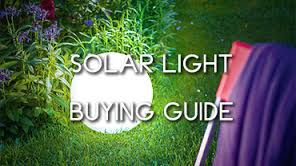
Read: Best Outdoor Lighting Ideas for your smart home
1. Quality of the solar cell.
There is not much variance here. All solar cells used by these lights produce roughly the same power for the same surface area. The difference is in the coatings. Cheap lights use plastics or other coatings that will yellow or cloud up over time. Better cells are covered with glass (and there are different kinds of glass that are better/worse). Best bet is to look for a glass covered cell and maintain it by keeping it clean.
Cell area determines how much power is delivered to the battery. A larger cell is needed for a full charge in dimly sunlit areas or places where the daylight is of short duration (shadows). Unfortunately all the lights I have seen are built to basically get a full battery charge given a full 8 or more hours of sunlight. The full charge is designed to give 6-8 hours of light from the LED after dark. The tinkerer types can combine the parts from two lights to either provide longer run time at night or get a full charge with a shorter daylight cycle.
2. Batteries.
Nickel Cadmium batteries (NiCd or 'NiCad')
The standard lights these days all use Nickel Cadmium (NiCd or 'NiCad') batteries. NiCads are generally cheap, reliable, and will give the longest service life compared to other battery types. NiCads however will all fail after a year or two since the number of cycles they can take (charged to discharged) is limited to a few hundred given the environment they operate in.Temperature range
NiCads also have the best temperature range and are the technology best suited for outdoor use.Most batteries can be easily replaced but watch out for 'oddball' battery sizes in the smaller lights. Also be aware that often the cost of new batteries is higher than the cost of the original light.
Avoid mixing battery types.
You cannot just replace NiCads with Nickel Metal Hydride (NiMH) batteries since the charging requirements are different. Most of these cheaper lights have really simple charging circuits and will just not work with other battery types.Keep the battery contacts clean!
The cheapest lights have poor sealing for the batteries and the contacts often get gummed up or corroded. This is a common cause of the lights losing their 'run time' or failing all together rather than dying a slow, graceful death due to the battery wearing out.
3. LEDs (Light Emitting Diodes)
Bright, power efficient LEDs are what made these lights possible. There is a careful balance between the size of the solar cell, battery, and LED. The cell must generate enough energy to charge the battery, the battery must store this energy, and the LED must use up this energy at a low enough rate to shine through the night.
Also read: Cheap Outdoor solar powered lighting for your Smart home
Better lights use better quality LEDs. A 'better quality' LED with be more power efficient, have a better light quality (this is the color rendering index or CRI), and be better focused. If you notice, the cheapest lights will have a harsh, bluish light. that seems to come from a single point. These are the cheapest LEDs to use. Better lights will have a 'warmer' glow and provide a more diffuse light pattern.

![CODE TO HIDE GOOGLE ADSENSE; TRANSPARENT ADS OVER VIDEO PLAY BUTTON [2016 TRICK] CODE TO HIDE GOOGLE ADSENSE; TRANSPARENT ADS OVER VIDEO PLAY BUTTON [2016 TRICK]](https://blogger.googleusercontent.com/img/b/R29vZ2xl/AVvXsEiGeTmQoSZf1STI5ExGEyD9goxlRjHU7dis1lUJZvXpQombSIHVDtIDSHuyHJPnf0xaSThAe3Qm_vd6liBrgQLBbaU2-787q3i03MBiHukt2-EdsJyla_cCxStEJEiDh61yqwLFNT3XBku5/s72-c/Screenshot_2016-02-23-23-35-19.png)
![[Updated 2017 ] Top 5 Google Adsense Earning Tricks 2016 And High CPC Tips [Updated 2017 ] Top 5 Google Adsense Earning Tricks 2016 And High CPC Tips](https://blogger.googleusercontent.com/img/b/R29vZ2xl/AVvXsEjI6AHme91WNQA8T7_7zyeCA5xLLlUH8OpvkGphY-lt7eW__TBHZ-CcOSSRth_jloAQJbQ4ByC0lSz35BxOoEOXujYTIoF9dYbhMGD1s4ycZOh1qNDpC43ozdYOjKnomadAqr9MU9bdgDrq/s72-c/top+5+adsense+earning+tricks+and+high+cpc+increasing+tips.jpg)






0 comments: